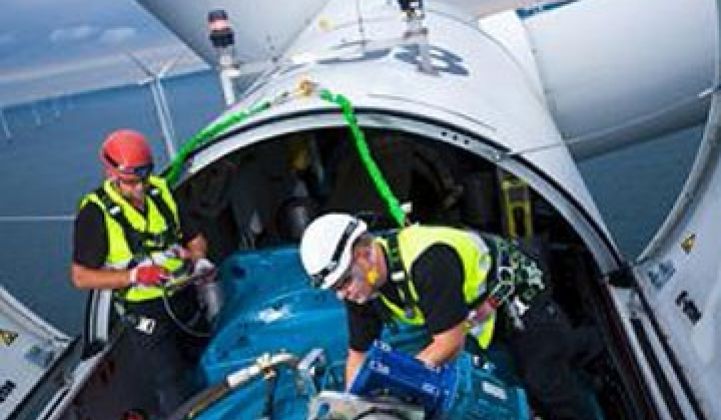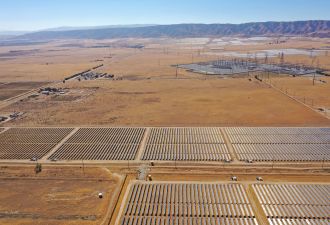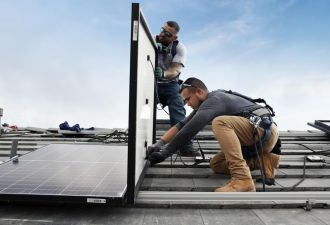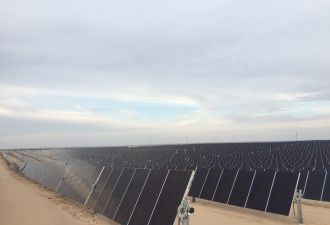For two to five years, a wind turbine is under warranty from the original equipment manufacturer (OEM) and has an annual maintenance schedule. Beyond that, operation and maintenance (O&M) maximizes the turbine's output and extends its life. With the cost of modern multi-megawatt turbines at over a million dollars per megawatt, O&M is key to a wind project's profitability.
Complete maintenance of a turbine requires the ongoing services of a two-technician crew. "Two people on the turbine from Monday morning until Friday night," elaborated Tim Holt, Siemens' Global CEO for Renewables Service. Siemens' technicians are permanently on site at the big projects for which it provides O&M services. For projects too small to keep a team busy year-round, Siemens assigns technicians to "local service centers."
The Siemens annual service, said Jacob Andersen, the company's Director of Wind Service for Region America and himself a former technician, is essentially a check of the turbine's safety and control systems. The technicians are trained to go through a detailed checklist that ranges from items such as, Andersen said, "a check and inspection of the mechanical and electrical systems" to "bolt tightening."
"It's a little like taking your car in for maintenance," Holt added. "We check the oil. We check the grease. We check the connections."
Like a car, a turbine requires regular maintenance. "The first service we do is after 500 hours of use," Andersen said. "After that we do annual service." Annual services vary. "We do more in year one and year five," he said.
Siemens is paid "an annual fee per turbine," Holt explained. It covers yearly maintenance plus an invaluable added service. "Each of the turbines has sensors at various parts," Holt said. "We have a permanent data connection that goes to our monitoring center in Houston. We have technicians or engineers monitoring the turbine twenty-four hours, seven days a week."
The cost for Siemens' O&M services is proprietary information and varies according to project and client. The general industry price -- "a very rough figure," Holt said -- is one to two Euro cents per kilowatt-hour.
Holt said the O&M business is highly competitive. "When the wind park is installed," he said, "the service is much more of a warranty support service." The OEM frequently does the O&M at that stage. "Then it's an open market. At that point, there are three types of competition. The OEM, independent service providers (ISPs), and the customers who self-perform the services."
All three competitors claim to get the best output, Holt said. The ISPs probably have the lowest cost, "because they tend to be small companies with low overhead." The Siemens O&M edge is its monitoring and diagnostics service from the Houston center, because this can help maximize turbine availability and output.
"How much time is your turbine available to produce electricity?" Holt asked. "When we do the service, our global figure is well above that of the availability figures for other service providers or self-perform service providers."
The Houston center uses state-of-the-art wind industry supervisory control and data acquisition (SCADA) technology. A turbine's multiple computer systems and network of sensors deliver information via fiber optic data cable to Houston, where it is carefully studied in real time.
In the event of a performance disruption, Siemens people in Houston either make adjustments from the control room or, if necessary, dispatch local technicians with precise support instructions. Technicians have a hotline to Houston, should they discover something during routine service.
"Every turbine we have in the world is connected," Andersen said. That's currently more than 2,000 turbines, he added. Everything from output, wind speed, and oil pressure to the frequencies of vibration of the main turbine components are under surveillance.
"We are capable of identifying any deviation in the condition of the turbine from a very early stage," Andersen explained, "and correcting the issue before it can result in a catastrophic failure."
Most problems, Holt said, "can be resolved by just resetting remotely." Holt compared turbine incidents to personal computer problems. "How often do you have to reboot your computer?" he asked. "Or how often does something fail where you have to get a replacement part?" Siemens has found that 75 percent to 80 percent of all turbine issues can be resolved from the remote diagnostics center in Houston.
On-site O&M work presents three unique challenges for technicians. One is working more than 200 feet in the air, another is being exposed to what is often very harsh weather and the third is working in the nacelle's very tight quarters. Siemens needs people, but will not hire technicians without special qualifications.
They must be skilled in managing the technology, methodical and organized enough to meet the challenges of working at great heights and in tight quarters, and highly responsible to keep a business-like attitude in the face of these daunting challenges. The training process is lengthy and comprehensive.
Holt named training technicians as his chief challenge. "We have 1,500 people in our global wind service organization. We're probably looking at tripling that size over the next four years," he said. "Siemens has about eleven gigawatts of wind installed. That number is going to grow fivefold over the next five years. If we don't get it right now, it's so much harder to get it right when you need to service five times the number of turbines."



